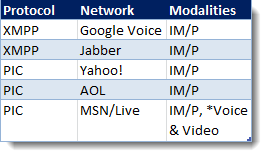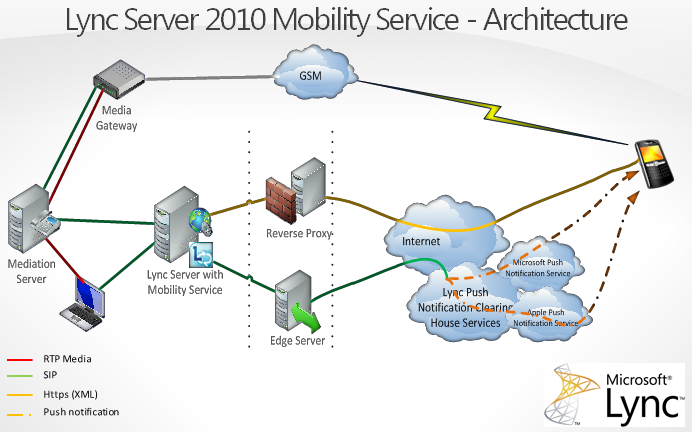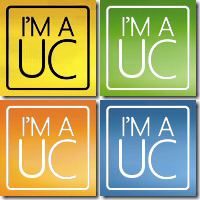| Lync Skill Search in SharePoint Server (on-premises) |
Yes |
No |
Yes |
| Lync Skill Search in SharePoint Online |
No |
No |
Yes |
| Persistent Group Chat |
Yes |
No |
No |
| Privacy mode |
Yes |
No |
No |
| Lync external connectivity (federation and Public IM connectivity) |
| IM/presence/audio/video federation with other OCS/Lync Server/Lync Online organizations |
Yes |
Yes |
Yes |
| IM/presence/audio/video with Windows Live Messenger |
Yes |
Yes |
Yes |
| IBM Sametime federation |
Yes |
No |
Yes |
| IM/presence federation with XMPP networks (Jabber, Google Talk) |
Yes |
No |
Yes – via customer hosted XMPP gateway |
| IM/presence with AOL, Yahoo |
Yes |
No |
No |
| Meetings (audio/video/web conferencing) |
| Meeting attendee capacity |
250 |
250 |
250 |
| Web Scheduler |
Yes (installed separately) |
Yes |
No |
| Desktop sharing |
Yes |
Yes |
Yes |
| Application sharing |
Yes |
Yes |
Yes |
| White boarding and annotations |
Yes |
Yes |
Yes |
| PowerPoint upload for online presentations |
Yes |
Yes |
Yes |
| Upload for other file types |
No |
No |
No |
| Multimedia content upload |
No |
No |
No |
| Polling |
Yes |
Yes |
Yes |
| Ad-hoc multiparty PC-based audio/video |
Yes |
Yes |
Yes |
| Authenticated attendee in Lync Web App |
Yes |
No |
Yes |
| Unauthenticated attendee in Lync Web App |
Yes |
Yes |
Yes |
| Lync attendee client |
Yes |
Yes |
Yes |
| Scheduled conferences (using Outlook plug-in) |
Yes |
Yes |
Yes |
| Outlook delegation for scheduling meetings |
Yes |
Yes |
Yes |
| Meeting join via Lync optimized conferencing devices See Meeting Room Devices. Note: Polycom CX7000 is not currently supported |
Yes |
Partial (RoundTable only) |
Yes (Polycom CX7000 is not currently supported) |
| Lobby |
Yes |
Yes |
Yes |
| Interoperability with certified partners for dial-in audio conferencing (ACP) |
No |
Yes |
No |
| Phone dial-out from scheduled meetings via third-party dial-in conferencing service |
No |
Yes |
No |
| Client side recording and playback |
Yes |
Yes |
Yes |
| Server-side recording and playback |
No |
No |
No |
| Generate a link to a scheduled meeting via web page |
No |
No |
No |
| Scheduling an online meeting in Outlook Web App |
No |
No |
No |
| Exchange Online Outlook Web App and Communicator 2007 R2 or Lync 2010 Integration |
No |
No |
Yes |
| Native dial-in audio conferencing on Lync server |
Yes |
No |
Yes |
| Screen Snapshot (Desktop Annotation) |
No |
No |
No |
| Backstage/Content Preview for presenters |
Yes |
Yes |
Yes |
| Mute all attendees |
Yes |
Yes |
Yes |
| Mute individual attendees |
Yes |
Yes |
Yes |
| Unmute all attendees |
Yes |
Yes |
Yes |
| Unmute individual attendees |
Yes |
Yes |
Yes |
| In-meeting attendee permission controls |
Yes |
Yes |
Yes |
| Interoperability with on-premises video conferencing systems |
Yes |
No |
Yes (via approved customer hosted gateway) |
| Voice and telephony |
| Lync-to-phone (calls with landlines and mobile phones) |
Yes |
Coming soon via (ACP) |
Yes |
| Call hold/retrieve |
Yes |
No |
Yes |
| Call-via-Work in Lync Mobile |
Yes |
No |
Yes |
| Dial-out from ad-hoc Lync meetings |
Yes |
No |
Yes |
| Advanced call controls (transfer, forward, simul-ring) |
Yes |
No |
Yes |
| Access to Exchange Online voicemail |
Yes |
No |
Yes |
| Team call |
Yes |
No |
Yes |
| Delegation (boss-admin) for Voice |
Yes |
No |
Yes |
| Call park |
Yes |
No |
Yes |
| Outgoing DID manipulation |
Yes |
No |
Yes |
| E-911 |
Yes |
No |
No |
| Dial plans and policies |
Yes |
No |
Yes |
| Common Area and IP desk phone support |
Yes |
No |
Yes |
| Resilient branch office appliance |
Yes |
No |
No |
| Call Admissions Control (CAC) |
Yes |
No |
No |
| Support for analog devices (such as FAX) |
Yes |
No |
No |
| Response groups |
Yes |
No |
No |
| Private Line (secondary DID for executives) |
Yes |
No |
Yes |
| Interoperability with third-party PBX or trunks |
Yes |
No |
Yes |
| Presence interoperability with third-party PBX |
No |
No |
No |
| RCC (click-to-call) with on-premises PBX |
Yes |
No |
No |
| Malicious call trace |
Yes |
No |
Yes |
| Unassigned number |
Yes |
No |
No |
| Network QoS – DSCP |
Yes |
No |
Yes |
| Media path optimization |
Yes |
No |
No |
| Phone number management |
Yes |
No |
No |
| CDR and billing reporting |
Yes |
No |
Yes |
| Integration with call center solutions (Aspect) |
Yes |
No |
No |
| Client support |
| Lync 2010 |
Yes |
Yes |
Yes |
| Lync Web App for participating in scheduled meetings |
Yes |
Yes |
Yes |
| Lync 2010 Attendee client (joining meetings) |
Yes |
Yes |
Yes |
| Communicator for Mac client |
Yes |
No |
Yes |
| Lync for Mac client |
Yes |
Yes |
Yes |
| Office Communicator Web Access (2007 R2) client |
Yes |
No |
No |
| Office Communicator 2007 R2 client |
Yes |
No |
No |
| Lync 2010 Phone Edition (Lync-based IP phones) |
Yes |
No |
Yes |
| Lync 2010 Attendant client (receptionist rich client) |
Yes |
No |
No |
| Communicator Mobile (Windows Phones 6.x) |
Yes |
No |
No |
| Lync 2010 Mobile client |
Yes |
Yes |
Yes |
| BlackBerry Enterprise Server integration for the BlackBerry client with the Lync Server 2010 |
Yes |
No |
Yes |
| IM and media encryption |
Yes |
Yes |
Yes |
| IM filtering |
Yes |
Yes |
Yes |
| Anti-malware scanning for meeting content and file transfers |
Yes (partner solutions) |
No |
No |
| IM archiving (server side) |
Yes |
No |
Yes |
| Exchange/SharePoint interoperability |
| Presence interoperability with Exchange and SharePoint on-premises |
Yes |
Yes |
Yes |
| Presence interoperability with Exchange Online and SharePoint Online |
Yes |
Yes |
Yes |
| Unified Messaging interoperability with Exchange Online |
Yes |
No |
Yes |
| Unified Messaging interoperability with Exchange on-premises |
Yes |
Yes (with Exchange 2010 Hybrid Server) |
No |
| Lync Online and Lync on-premises, and administration |
| Lync optimized common area phone and IP phone device auto updates |
Yes |
No |
Yes |
| Automatic Lync client update via inband client provisioning |
Yes |
No |
No |
| Server/cloud coexistence (split domain) on user basis (some users on-premises, some users online) |
No |
No |
No |
| Splitting workloads (for example, IM/presence/voice on-premises, conferencing in the cloud) |
No |
No |
No |
| PowerShell support |
Yes |
No |
No |
| Bigfin (web) UI |
Yes |
No |
No |
| Customer self-service configuration portal |
No |
Yes |
No |
| Attendee/user reporting |
No |
No |
No |
| Reporting (CDR, QoE) |
Yes |
No |
Yes |
| User Management via customer Active Directory |
Yes |
Yes (with ADFS 2.0) |
Yes |
| Third-party API support |
| Client-side APIs |
Yes |
Yes |
Yes |
| Server-side APIs |
Yes |
No |
No |
| Customer clients using Microsoft SDK |
Yes |
No |
No |












